
How humans have shaped plants and animals through artificial selection and domestication.
- Subject:
- Biology
- Life Science
- Material Type:
- Lesson
- Provider:
- Khan Academy
- Provider Set:
- Khan Academy
- Author:
- Sal Khan
- Date Added:
- 03/06/2019

How humans have shaped plants and animals through artificial selection and domestication.

This video segment explores the benefits and pitfalls of cloning as a means of reproduction. From Evolution: "Why Sex?"

This resource is a video abstract of a research paper created by Research Square on behalf of its authors. It provides a synopsis that's easy to understand, and can be used to introduce the topics it covers to students, researchers, and the general public. The video's transcript is also provided in full, with a portion provided below for preview:
"Microbial metagenomes are like a blueprint of all the functions performed by a microbial community. Some microbes can't be grown in the lab, so metagenomics is important for investigating otherwise-unknown microbial "dark matter". Short-read sequencing provides large amounts of data, but it's hard to assemble into complete genomes. A recent study combined short-read data with nanopore long-read data using Iterative Hybrid Assembly (IHA). The researchers reconstructed 49 metagenome-assembled genomes (MAGs), including some with very low coverage. In total, 34 MAGs did not belong to any known genus, representing unknown microbe groups. The IHA method revealed more of the genes present than a short-read-only approach and showed that the anammox genome of genus Ca. Brocadia contains two identical hydrazine synthase genes. The current method is best for enriched microbial communities and will be extended to high-complexity samples in the future..."
The rest of the transcript, along with a link to the research itself, is available on the resource itself.
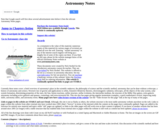
Astronomy Notes is a website with a brief overview of astronomy's place in the scientific endeavor, the philosophy of science and the scientific method, astronomy that can be done without a telescope, a history of astronomy and science, Newton's law of gravity and applications to orbits, Einstein's Relativity theories, electromagnetic radiation, telescopes, all the objects of the solar system, solar system formation, determining properties of the stars, the Sun, fusion reactions, stellar structure, stellar evolution, the interstellar medium, the structure of the Milky Way galaxy, extra-galactic astronomy including active galaxies and quasars, cosmology, and extra-terrestrial life. This site also has pages giving angular momentum examples, a quick mathematics review, improving study skills, astronomy tables, and astronomy terms

This course provides a graduate-level introduction to stellar astrophysics. It covers a variety of topics, ranging from stellar structure and evolution to galactic dynamics and dark matter.
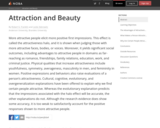
More attractive people elicit more positive first impressions. This effect is called the attractiveness halo, and it is shown when judging those with more attractive faces, bodies, or voices. Moreover, it yields significant social outcomes, including advantages to attractive people in domains as far-reaching as romance, friendships, family relations, education, work, and criminal justice. Physical qualities that increase attractiveness include youthfulness, symmetry, averageness, masculinity in men, and femininity in women. Positive expressions and behaviors also raise evaluations of a person’s attractiveness. Cultural, cognitive, evolutionary, and overgeneralization explanations have been offered to explain why we find certain people attractive. Whereas the evolutionary explanation predicts that the impressions associated with the halo effect will be accurate, the other explanations do not. Although the research evidence does show some accuracy, it is too weak to satisfactorily account for the positive responses shown to more attractive people.

Next generation sensors and a potential new ecosystem for marketing and advertising in augmented and virtual reality
Short Description:
Marketing is a competitive field that demands continuous improvement in the delivery of persuasive messaging to target audiences. The most recent successes in finding competitive advantage is achieved by professional marketers through technology. In this report, we will consider how Virtual Reality and Augmented Reality (AR/VR) will impact the marketing profession. We will review our research into the background of AR/VR, the sensor technologies that enable these advances, a review of the available hardware types, their positioning in the marketplace, and their use cases. We will then review current best practices in digital marketing as shared by key presenters at the 2017 University of New Hampshire Digital Marketing Conference. This will be the basis of a discussion about how AR/VR might embrace these current practices, cannibalize them, or depart from them to establish completely new methods. The new ecosystem driven by advances in VR and AR technology make a powerful new tool available to engage with their audiences at a new intense emotional and psychological level. We will discuss AR/VR’s evolving uses in entertainment, therapy, training and pornography. A review of risks is included. We conclude with analysis and projections for future use cases in social media, business practices, education, and for opportunities that may accrue to marketers because of AR/VR.
Long Description:
It’s 2017 and we stand upon the brink of another evolution in digital media. Since the first Turing architecture machine was invented to break codes in WWII, the ongoing technology evolution has led to a state of nearly ubiquitous computing, most recognizable in the form of modern smart phones. Stemming from the concurrent development in computing hardware and information processing, governments, businesses, and individuals created new marketplaces. These technologies established the ecosystem for the Internet and World Wide Web. Marketers and traditional marketing models adapted quickly to this ecosystem to the extent that digital marketing now dominates a typical marketing mix.
New technology innovations, known as Virtual Reality (VR) and Augmented Reality (AR), are developing at a rapid pace. The unique properties of fully immersive VR and situationally aware AR have great potential value to marketers seeking to engage and persuade consumers with impactful messaging. Marketers are starting to work with VR and AR as part of their toolbox for messaging. Its potential impact on existing marketing practices may turn out to be similar to what we have seen in the transition to digital marketing. In this report, we will describe AR/VR hardware technology and how it may enable new ecosystems to develop for marketing and advertising.
Word Count: 21293
(Note: This resource's metadata has been created automatically as part of a bulk import process by reformatting and/or combining the information that the author initially provided. As a result, there may be errors in formatting.)
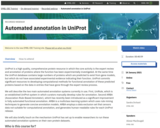
UniProt is a high quality, comprehensive protein resource in which the core activity is the expert review and annotation of proteins where the function has been experimentally investigated. At the same time the UniProt database contains large numbers of proteins which are predicted to exist from gene models, but which do not have associated experimental evidence indicating their function. UniProt commits significant resources to developing computational methods for functional annotation of these predicted proteins based on the data in entries that have gone through the expert review process.
We will describe the two main automated annotation systems currently in use. First, UniRule, which is an established UniProt system in which curators manually develop rules for annotation. Second ARBA (Association-Rule-Based Annotator), which has recently been introduced as a significant improvement in fully automated functional annotation. ARBA is a multiclass learning system which uses rule mining techniques to generate concise annotation models. ARBA employs a data exclusion set that censors data not suitable for computational annotation, and generates human-readable rules for each UniProt release.
We will also briefly touch on the mechanism UniProt has set up to enable researchers to run these automated annotation systems on their own protein datasets.
Who is this course for?
This webinar is for scientists and bioinformaticians with an interest in functional annotation of protein sequences.
Outcomes
By the end of the webinar you will be able to:
Recall the role of UniProt's two main automated annotation systems
Describe how UniRule and ARBA work
Get started using these automated annotation systems

Ayurveda is the mother of all forms of modern medicine, from body work to surgery. Ayurveda is an ancient time tested method of holistic medicine that supports the individual in finding balance throughout their physiology leading to great levels of health s and happiness. It is well known that the oldest of all the sciences in the world is the science of life, Ayurveda. It is based entirely on herbs and herbal compounds. The scientific method of Modern Science is based on the principle of Observation, Hypothesis / anti-thesis, Experimentation and Proof. Present form of Ayurveda is the outcome of continued scientific inputs that has gone in to the evolution of its principles, theories and protocol of healthy living and disease management. In this paper an attempt has been done to highlight various plants of Ayurveda and their exploration in the scientific research. The evidences of effect of different Ayurvedic plant extracts, formulations (herbal product, bhasmas etc) by in vitro, in vivo studies and clinical trials is extremely helpful in enhancing the wisdom of Ayurveda as evidence-based Indian system of medicine.

Syllabus and lab manual to accompany course using OpenStax Concepts of Biology (https://openstax.org/details/books/concepts-biology).
Course description: Centers on concepts of unity of living organisms including evolution, biochemistry, cell biology (morphology and physiology), genetics and development.
Lab manual begins on p. 11.
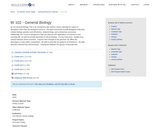
This is an introductory lab science course intended for majors in disciplines other than the biological sciences. The topics presented include biological molecules, cellular biology, genetics and inheritance, biotechnology, and evolutionary processes. Additionally, the course is designed to help you discover the applications of science in your everyday life, as well as provide elements of critical thinking.
Course Outcomes:
1. Explain how natural selection drives evolution.
2. Express how changes in the genome can affect the phenotype or traits within a population.
3. Be able to describe the patterns of inheritance.
4. Be able describe selected key cell processes.
5. Distinguish between the groups of biomolecules.
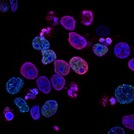
Biological principles emphasizing structure and function at the molecular, cellular, and organismal levels of biological systems. Secondary school chemistry is strongly recommended. Primarily for biology majors and pre professional students in health-related fields.Required Text: Biology 2nd Edition - OpenStax.orgLinks to an external site. - The textbook is free to download and is always available in the left navigation of your Canvas course. Please see the getting started module for more information on how the textbook will be used in the course. ISBN-10: 1-947172-52-2 ISBN-13: 978-1-947172-52-4BIO 181 Course Content: Scientific Method Basic chemistry and biological macromolecules Organization of cells Energy and Enzymes Photosynthesis Cellular respiration Cell division Genetics Gene expression and regulation Gene technology Data collection and analysis
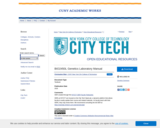
This is a lab manual for a course on Genetics.
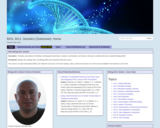
Principles and problems of heredity, including gene transmission, mutation, recombination, and function

The fundamentals of biological macromolecular structures; an introduction to the computational tools important in determining biological functions. (This course is the same as Computer and Information Science 2810W.) Writing-intensive course.

This textbook is a collection of technology guides to help students understand the technical aspects of bioinformatics.

A Metabiological Pentateuch
Short Description:
In this bold cycle of five plays, featuring an extensive introduction, George Bernard Shaw examines society’s ills and imagines a solution which takes his audience from the Garden of Eden to as far as thought can reach.
Long Description:
Can modern civilization honestly hope to have competent leaders, given that the complexities of society are too great for any one person to truly grasp? Even back in 1921, George Bernard Shaw thought such expectations were unrealistic. How then can contemporary societies hope to thrive?
For modern civilizations to prosper, Shaw argues that increased longevity is essential. In Back to Methuselah: A Metabiological Pentateuch, Shaw imagines a history in which extreme longevity can be reached through creative evolution, a process motivated by humanity’s creative impulse. Although Shaw rooted his theories in Lamarckian science, which has since fallen out of scientific favor, Shaw’s artistic achievements continue to demand our attention.
Back to Methuselah features an extensive introduction that details Shaw’s ideas and five plays which bring those ideas to life, imagining a new human history, stretching out one idea, one myth, from the Garden of Eden to as far as thought can reach. A metabiological pentateuch, indeed.
Word Count: 112336
(Note: This resource's metadata has been created automatically as part of a bulk import process by reformatting and/or combining the information that the author initially provided. As a result, there may be errors in formatting.)
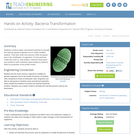
Students construct paper recombinant plasmids to simulate the methods genetic engineers use to create modified bacteria. They learn what role enzymes, DNA and genes play in the modification of organisms. For the particular model they work on, they isolate a mammal insulin gene and combine it with a bacteria's gene sequence (plasmid DNA) for production of the protein insulin.

This resource is a video abstract of a research paper created by Research Square on behalf of its authors. It provides a synopsis that's easy to understand, and can be used to introduce the topics it covers to students, researchers, and the general public. The video's transcript is also provided in full, with a portion provided below for preview:
"Colorectal cancer is the fourth most common cancer and the fifth leading cause of cancer death worldwide. Two important hallmarks of the disease are faulty tumor suppressor genes and altered composition of the community of microbes that live in the colon. That prompted researchers to explore whether there is a connection between the two. They examined 33 tissue samples from patients with colorectal cancer. Protein-assisted DNA sequencing revealed the prominence of Fusobacterium nucleatum, pathogenic bacteria associated with gum disease, and Hungatella hathewayi, rod-shaped bacteria with no substantial track record of causing disease. Further experiments showed that these bacteria can actually mute genes that normally suppress cancer, promoting the spread of colorectal cancer cells. The findings are unexpected evidence that bacteria in the colon can regulate genes linked to cancer suppression and reveal at least a few targets for anti-cancer therapy..."
The rest of the transcript, along with a link to the research itself, is available on the resource itself.
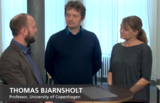
In this presentation, we talk about adaptation and evolution of bacteria. Furthermore, we will discuss how you can work with or against evolution, regarding the treatment of bacteria and biofilms.